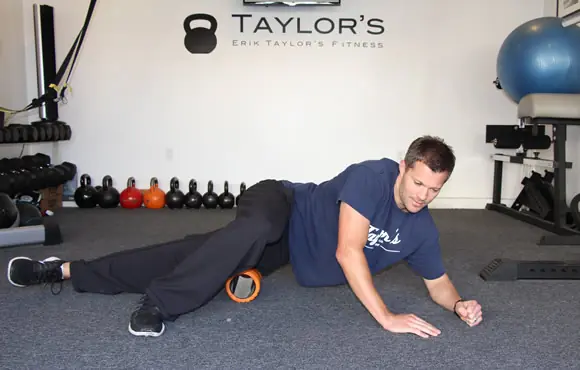The benefits of a post-workout massage can help remove lactic acid from the muscles, prevent injury and improve flexibility. But instead of spending $60 per hour a few times per week, a $40 foam roller can give you many of the same benefits.
If you're new to foam rolling or even a veteran, 10 to 15 minutes three to five days a week can help your body move more freely, recover more quickly and improve your overall range of motion so you can train at a higher level more frequently.
These simple exercises target six of the most overworked and injured muscle groups among cyclists and triathletes.
ITB (Iliotibial band)
1 of 7
The ITB runs from the side of the hip to its insertion point in the tensor fasciae latae (TFL) just below the knee.
1. Lie on your right side and place the foam roller perpendicular under your right hip.
2. Use your left hand and right forearm to support your bodyweight.
3. Cross your left leg over the right leg so that your left foot is flat on the floor.
4. Roll from your hip down to just above your right knee for 30 seconds to two minutes. Switch to the opposite leg and repeat.
Thoracic
2 of 7
The thoracic spine begins below the bony prominence at the base of the neck and ends at the mid-back.
1. Lying on the floor face up, place the foam roller perpendicular to your upper back.
2. Place both feet flat on the floor with your knees bent to a 90-degree angle, similar to the starting position of a sit-up. Support your head by clasping both hands at the base of the neck.
3. Raise your hips off the floor and roll back and forth from your shoulder blades to the mid-back for 30 seconds to two minutes.
Adductors
3 of 7
Adductor muscles begin in the groin and run along the inside of the thigh to the knee.
1. Lie prone on the floor with your body weight supported on your elbows.
2. Place the foam roller against your inner thigh. Bend the knee of the leg you are rolling.
3. Roll from the groin to just above the knee on the inside part of your thigh for 30 seconds to two minutes. Switch to the opposite leg and repeat.
Piriformis
4 of 7
The piriformis muscle begins at the sacrum (part of the spine) and ends at the femur at the hip joint, forming the upper posterior hip/buttock.
1. Sit on the floor and place a lacrosse ball (or something of a similar size) under your right glute.
2. Use your hands for support by placing them flat on the floor.
3. Use small movements to roll out the posterior hip for 30 seconds to two minutes.
4. If you find areas that are tender to the pressure, concentrate on these areas for five to 10 seconds at a time. Switch to the left glute and repeat.
Quadriceps
5 of 7
The quadriceps are the four muscles that make up the front part of the thigh.
1. Lie face-down on the floor.
2. Place the foam roller perpendicular to your legs to target the quads.
3. Come up onto your elbows to support your bodyweight.
4. Roll from the top of your quad to just above your knee for 30 seconds to two minutes. Switch to the opposite leg and repeat.
Soleus/Calf
6 of 7
The soleus runs from the back of the knee to its insertion point on the Achilles tendon.
1. Sit down on the floor with your legs stretched out in front of you.
2. Put the foam roller perpendicular to your right calf.
3. Cross your left leg over your right ankle.
4. Place your hands flat on the floor to support your bodyweight as you rise up.
5. Roll from the upper portion of your calves to the back of your ankle and back up for 30 seconds to two minutes. Switch to the opposite leg and repeat.






Discuss This Article